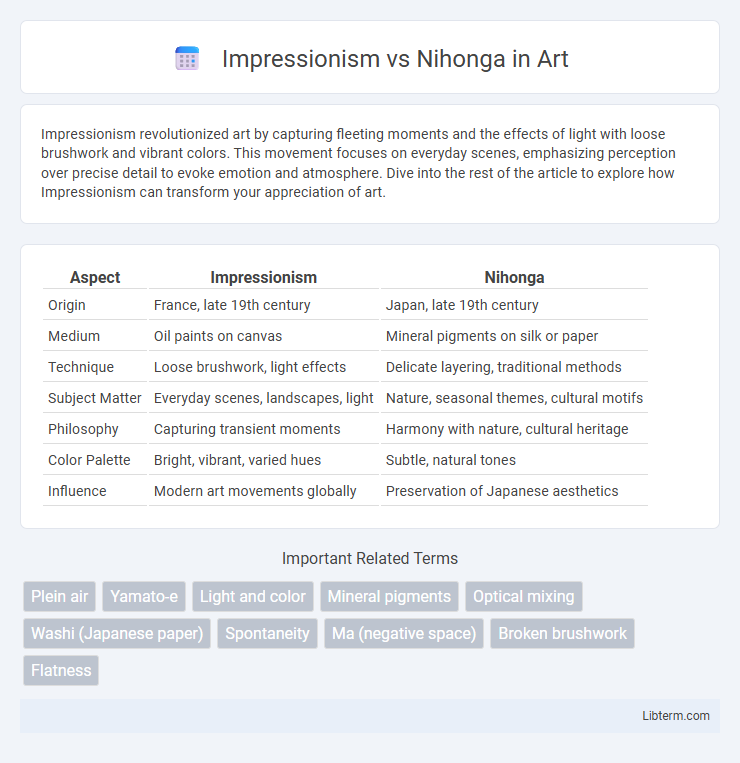Impressionism revolutionized art by capturing fleeting moments and the effects of light with loose brushwork and vibrant colors. This movement focuses on everyday scenes, emphasizing perception over precise detail to evoke emotion and atmosphere. Dive into the rest of the article to explore how Impressionism can transform your appreciation of art.
Table of Comparison
| Aspect | Impressionism | Nihonga |
|---|---|---|
| Origin | France, late 19th century | Japan, late 19th century |
| Medium | Oil paints on canvas | Mineral pigments on silk or paper |
| Technique | Loose brushwork, light effects | Delicate layering, traditional methods |
| Subject Matter | Everyday scenes, landscapes, light | Nature, seasonal themes, cultural motifs |
| Philosophy | Capturing transient moments | Harmony with nature, cultural heritage |
| Color Palette | Bright, vibrant, varied hues | Subtle, natural tones |
| Influence | Modern art movements globally | Preservation of Japanese aesthetics |
Introduction to Impressionism and Nihonga
Impressionism emerged in 19th-century France, characterized by its focus on light, color, and everyday scenes captured through loose brushwork and vivid palettes, aiming to convey sensory impressions rather than precise details. Nihonga, a traditional Japanese painting style developed during the Meiji period, integrates classical techniques and natural pigments on washi paper or silk, emphasizing harmony with nature and cultural heritage. Both artistic movements reflect distinct cultural aesthetics, with Impressionism pioneering modern Western art's embrace of spontaneity and Nihonga preserving Japanese artistic identity through refined craftsmanship.
Historical Origins and Development
Impressionism emerged in the late 19th century in France as a radical departure from traditional academic painting, emphasizing light, color, and everyday scenes. Nihonga developed during the Meiji period in Japan, blending classical Japanese painting techniques with Western influences to preserve cultural identity amidst modernization. Both movements reflect pivotal historical shifts, with Impressionism revolutionizing Western art and Nihonga safeguarding Japanese aesthetics during rapid societal change.
Foundational Philosophies
Impressionism centers on capturing fleeting moments and the effects of light with loose brushwork and vibrant colors, emphasizing perception over detail. Nihonga, rooted in traditional Japanese techniques and materials, prioritizes harmony with nature, subtlety, and spiritual depth, often reflecting Shinto and Buddhist aesthetics. Both movements represent distinct foundational philosophies: Impressionism's embrace of modernity and sensory experience contrasts with Nihonga's reverence for cultural heritage and meditative expression.
Key Influences and Cultural Context
Impressionism emerged in 19th-century France, heavily influenced by the rapid urbanization and technological advances of the Industrial Revolution, emphasizing light, color, and momentary impressions in landscapes and everyday scenes. Nihonga, rooted in traditional Japanese aesthetics, draws from historical art forms such as Yamato-e and Buddhist painting techniques, reflecting a cultural reverence for nature, spirituality, and formal symbolism during Japan's Meiji Restoration period. Both movements respond to their unique socio-political environments, with Impressionism challenging academic conventions and Nihonga seeking to preserve Japanese identity amid Western modernization.
Distinct Artistic Techniques
Impressionism emphasizes loose brushwork and the use of light and color to capture fleeting moments and atmospheric effects, often utilizing broken color and visible strokes for dynamic visual impressions. Nihonga, rooted in traditional Japanese aesthetics, employs meticulous brush techniques, mineral pigments, and layered washes on handmade paper or silk, focusing on delicate detail and symbolic natural motifs. The contrast lies in Impressionism's spontaneous, vibrant execution versus Nihonga's precise, refined craftsmanship grounded in cultural heritage.
Color Usage and Materials
Impressionism emphasizes vibrant, light-infused colors achieved through oil paints on canvas, capturing natural light and fleeting moments with bold brushstrokes and visible texture. Nihonga employs traditional Japanese mineral pigments called "iwaenogu," mixed with animal glue on silk or paper, resulting in more subdued, layered colors that highlight subtle gradations and natural themes. The distinct materials and color techniques of Impressionism and Nihonga reflect their cultural origins and artistic philosophies, with Impressionism prioritizing immediacy and Nihonga valuing meticulous craftsmanship.
Iconic Artists and Masterpieces
Impressionism, led by iconic artists like Claude Monet and Pierre-Auguste Renoir, revolutionized painting with masterpieces such as Monet's "Water Lilies" and Renoir's "Dance at Le Moulin de la Galette," emphasizing light and color through loose brushwork. Nihonga, a traditional Japanese painting style, is exemplified by masters like Yokoyama Taikan and Kaii Higashiyama, with renowned works including Taikan's "Metempsychosis" and Higashiyama's "Road," blending classical Japanese techniques with modern aesthetics. Both movements reflect distinct cultural aesthetics and artistic philosophies, shaping their respective art histories worldwide.
Subject Matter and Themes
Impressionism emphasizes capturing the fleeting effects of light and everyday scenes through loose brushwork and vibrant colors, often portraying landscapes, urban life, and leisure activities. Nihonga, rooted in traditional Japanese aesthetics, focuses on natural subjects such as flora, fauna, and seasonal changes, using mineral pigments on silk or paper to evoke subtle beauty and cultural symbolism. While Impressionism reflects modernity and spontaneity, Nihonga preserves classical themes and national identity through meticulous detail and harmony.
Evolution in Modern Art
Impressionism revolutionized modern art by emphasizing light, color, and brushstroke spontaneity, breaking away from rigid academic traditions in late 19th-century Europe. Nihonga evolved in Japan as a response to Western influence, blending traditional Japanese techniques with modern themes to preserve cultural identity while adapting to contemporary aesthetics. Both movements significantly shaped the trajectory of modern art by challenging conventions and inspiring new artistic expressions worldwide.
Lasting Impact and Global Legacy
Impressionism revolutionized Western art by emphasizing light, color, and everyday subjects, influencing generations of artists and shaping modern art movements globally. Nihonga preserved traditional Japanese aesthetics while integrating selective Western techniques, sustaining cultural heritage and inspiring contemporary Japanese artists worldwide. Both movements significantly impacted their respective cultures and contributed to a diverse, interconnected global art legacy.
Impressionism Infographic

 libterm.com
libterm.com